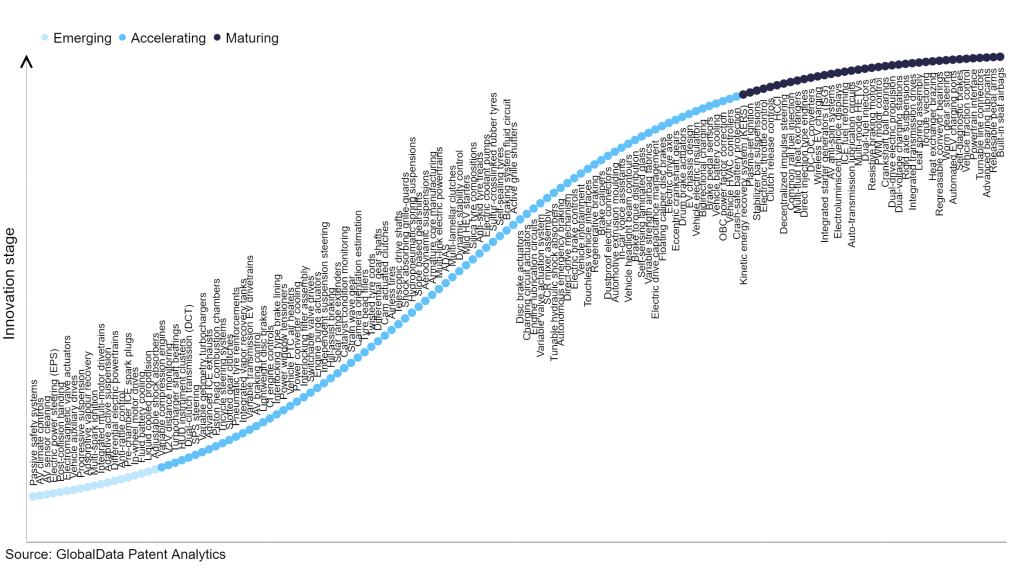The automotive industry continues to be a hotbed of patent innovation. Activity is driven by safety concerns, regulations and vehicle electrification, and growing importance of technologies such as brake-by -wire and regenerative braking. In the last three years alone, there have been over 1.7 million patents filed and granted in the automotive industry, according to GlobalData’s report on Innovation in Innovation in automotive: interlocking type brake lining. Buy the report here.
However, not all innovations are equal, and nor do they follow a constant upward trend. Instead, their evolution takes the form of an S-shaped curve that reflects their typical lifecycle from early emergence to accelerating adoption, before finally stabilizing and reaching maturity.
Identifying where a particular innovation is on this journey, especially those that are in the emerging and accelerating stages, is essential for understanding their current level of adoption and the likely future trajectory and impact they will have.
300+ innovations will shape the automotive industry
According to GlobalData’s Technology Foresight, which plots the S-curve for the automotive industry using innovation intensity models built on over one million patents, there are 300+ innovation areas that will shape the future of the industry.
Within the emerging innovation stage, integrated multi-motor drivetrains, electric power steering (EPS), and post-collision handing are useful technologies that are in the early stages of wider application and should be tracked closely. Variable compression engines, V2V distance monitoring, and turbocharger shaft bearings are some of the accelerating innovation areas, where adoption has been steadily increasing. Among maturing innovation areas are kinetic energy recovery system (KERS) and plasma-jet ignition, which are now well-established in the industry.
Innovation S-curve for the automotive industry

Interlocking type brake lining is a key innovation area in automotive
Interlocking type brake linings apply frictional forces to a cylindrical drum attached to the wheel during braking operations to decrease its speed and provide better control of the vehicle.
GlobalData’s analysis also uncovers the companies at the forefront of each innovation area and assesses the potential reach and impact of their patenting activity across different applications and geographies. According to GlobalData, there are 30+ companies, spanning technology vendors, established automotive companies, and up-and-coming start-ups engaged in the development and application of interlocking type brake lining.
Key players in interlocking type brake lining – a disruptive innovation in the automotive industry
‘Application diversity’ measures the number of applications identified for each patent. It broadly splits companies into either ‘niche’ or ‘diversified’ innovators.
‘Geographic reach’ refers to the number of countries each patent is registered in. It reflects the breadth of geographic application intended, ranging from ‘global’ to ‘local’.
Patent volumes related to interlocking type brake lining
| Company | Total patents (2010 - 2022) | Premium intelligence on the world's largest companies |
| COSCO Shipping | 44 | Unlock Company Profile |
| Nippon Steel | 95 | Unlock Company Profile |
| Tata Motors | 3 | Unlock Company Profile |
| Akebono Brake Industry | 32 | Unlock Company Profile |
| Nisshinbo | 13 | Unlock Company Profile |
| Daido Steel | 6 | Unlock Company Profile |
| Schaeffler | 10 | Unlock Company Profile |
| Miba | 18 | Unlock Company Profile |
| Robert Bosch Stiftung | 11 | Unlock Company Profile |
| SEW-EURODRIVE | 11 | Unlock Company Profile |
| Westinghouse Air Brake Technologies | 79 | Unlock Company Profile |
| Nucap Industries Inc | 30 | Unlock Company Profile |
| Tenneco | 13 | Unlock Company Profile |
| General Motors | 5 | Unlock Company Profile |
| Icahn Enterprises | 13 | Unlock Company Profile |
| Nabtesco | 8 | Unlock Company Profile |
| ITT | 12 | Unlock Company Profile |
| Sumitomo Bakelite | 20 | Unlock Company Profile |
| Safran | 13 | Unlock Company Profile |
| Honeywell International | 7 | Unlock Company Profile |
| Fine Sinter | 29 | Unlock Company Profile |
| Central Japan Railway - Tokyo Head Office | 3 | Unlock Company Profile |
| PureForge | 9 | Unlock Company Profile |
| Gienanth | 5 | Unlock Company Profile |
| Util Industries | 5 | Unlock Company Profile |
| Beijing Tianyishangjia New Material | 25 | Unlock Company Profile |
| Beijing Bei Mo Gao Ke Friction Material | 8 | Unlock Company Profile |
| KnorrBremsesysteme Fuer Schienenfahrzeuge | 2 | Unlock Company Profile |
| Nanjing Zhongsheng Rolling Stock Components | 2 | Unlock Company Profile |
| Stemco Products | 4 | Unlock Company Profile |
| Stella Vermogensverwaltungs | 89 | Unlock Company Profile |
| Nuova FourB | 10 | Unlock Company Profile |
Source: GlobalData Patent Analytics
Nippon Steel is a key player in the interlocking type brake lining innovation area. The company’s interlocking-type brake lining helps in reducing emissions, running resistance, and engine displacement for better fuel efficiency. Nippon’s interlocking-type brake lining requires little maintenance, is more reliable, and offers protection. Stella Vermogensverwaltungs, Westinghouse Air Brake Technologies, COSCO Shipping, and Akebono Brake Industry are some of the other key players.
In terms of application diversity, General Motors held the top position, while Nucap and Daido Steel stood in second and third positions, respectively. By means of geographic reach, ITT leads the pack, followed by SEW-EURODRIVE and Nippon Steel.
To further understand the key themes and technologies disrupting the automotive industry, access GlobalData’s latest thematic research report on Automotive.
Premium Insights
From

The gold standard of business intelligence.
Blending expert knowledge with cutting-edge technology, GlobalData’s unrivalled proprietary data will enable you to decode what’s happening in your market. You can make better informed decisions and gain a future-proof advantage over your competitors.






